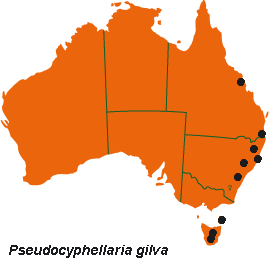



Australian Biological Resources Study
| Checklist of the Lichens of Australia and its Island Territories | ||
| Introduction | A–D | E–O | P–R | S–Z | Oceanic Islands | References | ||
| Pseudocyphellaria gilva (Ach.) Malme | ||
| Bih. Kongl. Svenska Vetensk.-Akad. Handl. 25(3/6): 32 (1899); Lichen gilvus Ach., Lich. Suec. Prodr. 157 (1799). T: "Cap B. Spei" [Cape of Good Hope], South Africa, C.P.Thunberg; lecto: UPS-THUNBERG 26816, fide D.J.Galloway, Biblioth. Lichenol. 46: 130 (1992). | ||
| Thallus rosette-forming to irregularly spreading, loosely attached, 2–12 (–20) cm wide; margins ±free. Lobes broadly rounded, 1–3 cm wide and with ±dichotomously branching apices to ±regularly dichotomously branched and 2–6 mm wide, contiguous to complex-imbricate; lobe margins entire, thickened above and below, with or without prominent projecting yellow pseudocyphellae. Upper surface pale greyish brown or olive-brown or chestnut-brown when dry, dark blue-black suffused red-brown when wet, undulate to faveolate, matt or slightly glossy, minutely maculate; without isidia, phyllidia, pseudocyphellae or soredia. Maculae effigurate to reticulate (×10 lens), white to red-brown. Medulla white. Photobiont Nostoc. Lower surface pale to dark brown to ±black, glabrous at margins, tomentose centrally; tomentum woolly, red-brown to black. Pseudocyphellae prominent, yellow, conical-verruciform, round to irregularly sulcate, 0.05–0.6 mm diam.; margins swollen, concolorous with lower cortex; decorticate area plane to concave. Apothecia rare to occasional, marginal and laminal, sessile to subpedicellate; disc pale to dark red-brown, occasionally faintly grey-pruinose; exciple at first brick-red to orange, becoming greyish with age; epithecium red-brown to dark olive-brown, K+ purplish brown; hymenium pale yellow-brown; hypothecium dark yellow-brown, K–. Ascospores fusiform-ellipsoidal, 1–3-septate, 22–30 × 9–11 µm, red-brown. CHEMISTRY: Tenuiorin, methyl gyrophorate, hopane-6α,7β,22-triol, stictic acid, cryptostictic acid, constictic acid, norstictic acid (trace), calycin, pulvinic acid and pulvinic dilactone. |  |
|
| Occurs in eastern Qld, eastern N.S.W. and Tas., on living and dead wood and on rocks in open, well-lit situations in forest and scrub. Also in the Palaeotropics from the Cape of Good Hope to New Guinea, and in southern South America. | ||
| Galloway et al. (2001) | ||
| Checklist Index |
| Introduction | A–D | E–O | P–R | S–Z | Oceanic Islands | References |
This work is copyright. Apart from any use as permitted under the Copyright Act 1968, no part may be reproduced by any process without prior written permission from Australian Biological Resources Study. Requests and inquiries concerning reproduction and rights should be addressed in the first instance to Dr P. McCarthy. These pages may not be displayed on, or downloaded to, any other server without the express permission of ABRS.